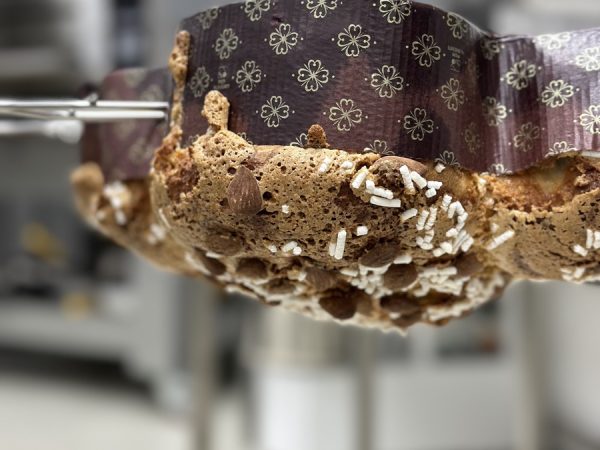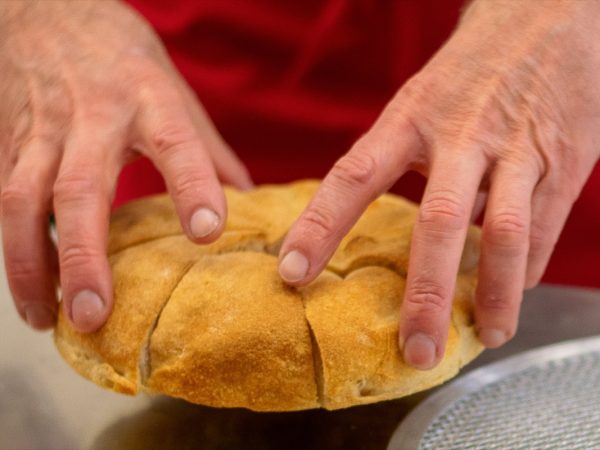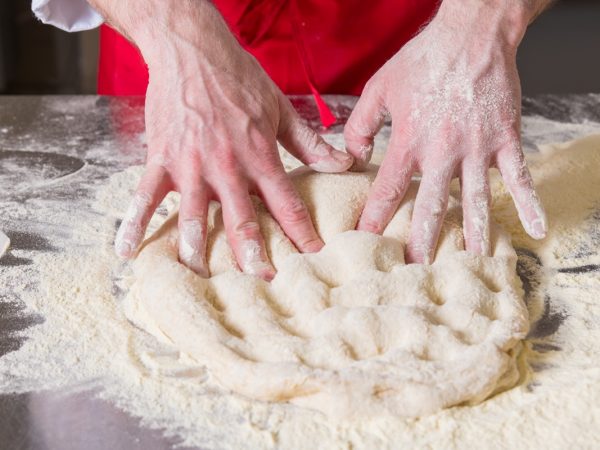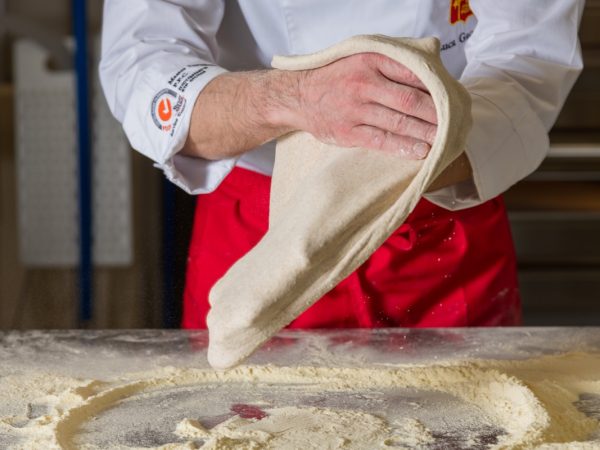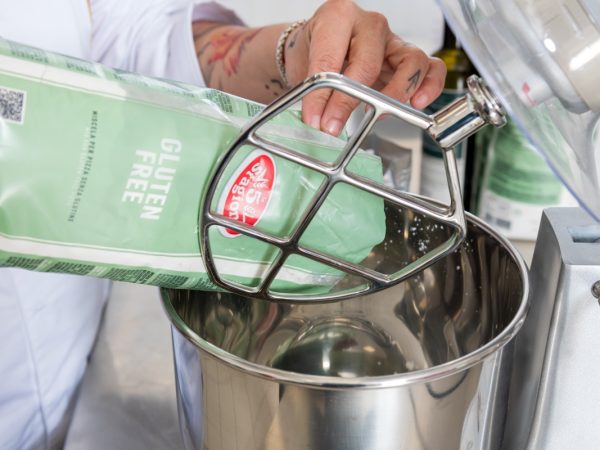Recent scientific studies have shown that the number of people with celiac disease is steadily increasing. Pasta, beer, and other gluten-free baked goods are the most striking examples of a gradual and steady transformation in consumption patterns. These ongoing changes in dietary habits are contributing to the identification of a new target audience in the restaurant industry, with specific nutritional needs.
The Gluten-Free Pizza course by the Italian School of Pizzaioli aims to teach how to produce an optimal dough and how to organize the workspace to serve customers in total safety. The theoretical part will be led by a professional trainer in gluten-free catering, while the practical part will be handled by Master Instructors with Certified Training Pathway specialized in creating gluten-free doughs.
The course is aimed at those who want to learn the different techniques of production, preparation, stretching, and baking of gluten-free pizza. It is suitable for professional pizza chefs and restaurant owners who wish to deepen their theoretical and practical knowledge needed to successfully operate in the gluten-free catering sector, including best practices in pizzerias, development of specific menus, and knowledge of dedicated equipment and clothing.
Deepen Your Knowledge: specialization courses
Showing all 9 results
- Gluten-free course
- Course in Large Leavened Products and Petit Fours
- Neapolitan STG and Contemporary
- Bread in Pizzeria
- PAN PIZZA
- Pizza in Pala and Teglia
- Pre-ferments in Pizzeria
Gluten-free course
What You Will Learn
Complete professional preparation in the world of gluten-free. The course will enable you to learn dough techniques, shaping, and baking of various types of pizza along with all the essential aspects to organize your gluten-free production in total safety.
Duration
16 hours divided over 2 days: 4 hours of theoretical lessons and 12 hours of practical lessons.
From 9:00 AM to 5:00 PM
Language
Italian
Course program
Theory
4 Hours
- Gluten-free pizza: raw materials, suitable toppings and beverages, labeling, and certifications for safe sourcing.
- Procedures and best practices in pizzeria: storage, processing, cooking, dining room and takeout service
- The gluten-free menu: welcoming and communicating with celiac customers
- HACCP and food safety regulations in gluten-free operations
- Dedicated equipment and attire
Practice
12 Hours
- Making gluten-free dough mixture by hand and with a dough mixer
- Making dough with alternative flours
- Technique of mixing, shaping, and stretching
- Calibration and baking in an electric oven within the times required for gluten-free pizza
- Preparation of gluten-free biga (pre-ferment)
- Making gluten-free dough for teglia and pala
- Pre-baking and baking in an electric oven
- Plating of the gluten-free pizza
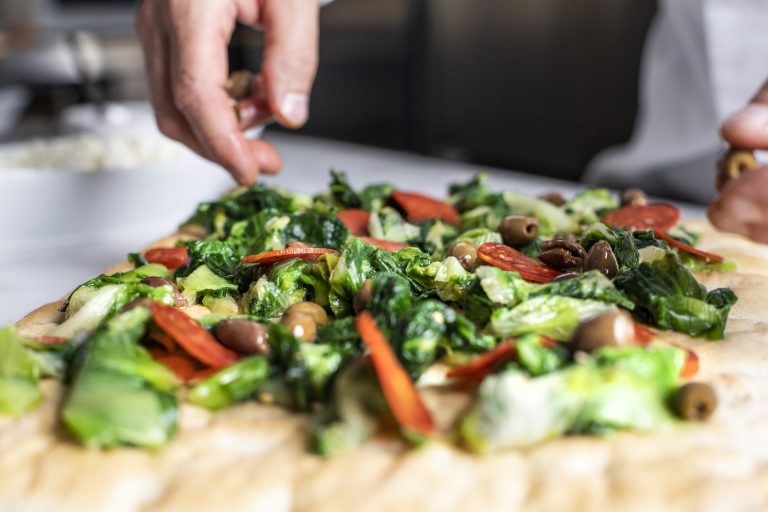
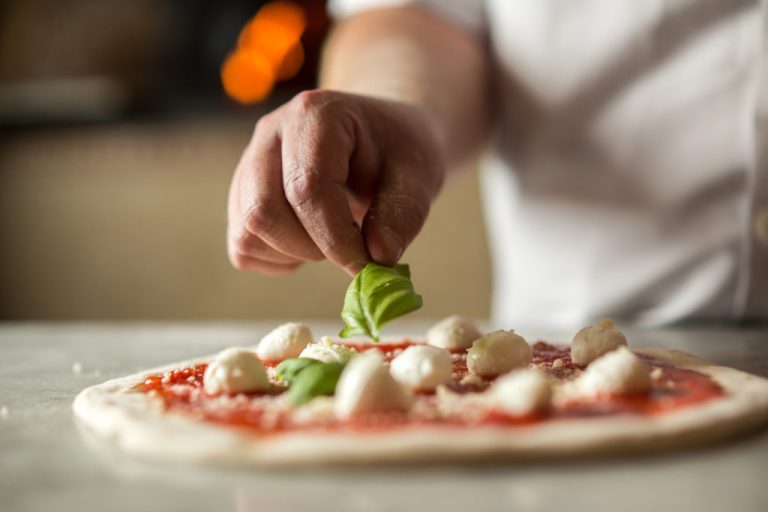
Course in Large Leavened Products and Petit Fours
The world of large leavened products is increasingly approaching pizzerias that need to expand their clientele with new products beyond their own pizza.
In this course, we will cover the theory and practice necessary to prepare some iconic leavened products such as panettone, colomba, and sweet focaccia. Techniques for mixing and baking will be explained to achieve a light and tasty large leavened product in a pizzeria with different types of flour, to offer customers a quality, personalized, and exclusive product.
Part of the course will be dedicated to small pastry making, including the creation of products ideal for any pizzeria such as cookies, shortcrust pastry (tarts), sponge cake, and plumcake, which will allow for an expansion of the menu with homemade products. This will enhance the venue by completing the gastronomic offer and making use of existing equipment without additional investments.
The course is aimed at professionals and owners of pizzerias and restaurants who want to deepen their understanding of the theory and practice necessary to make panettone, colomba, and sweet focaccia in their own pizzeria, and to acquire skills in the world of small pastry making like cookies, shortcrust pastry, sponge cake, and plumcake.
What You Will Learn
A thorough level of knowledge and preparation on the different types of dough, production techniques, and high-quality raw materials necessary for making traditional large leavened products, as well as a focus on small pastry to complement the gastronomic offerings of your venue.
Duration
16 hours spread over 2 days: 2 hours of theoretical lessons and 14 hours of practical lessons.
From 9:00 AM to 5:00 PM
Language
Italian
Course program
Theory
2 Hours
- Cereals, flour: organoleptic characteristics, proteins, gluten, starch, enzymes
- Yeast: morphology, metabolism in the absence and presence of oxygen, production, its role in the dough, yeast action in relation to temperatures, the leavening curve, and different types of yeast
- The most suitable flours for preparing large leavened products in pizzerias
- Mixes or semi-finished products: what they are and how they simplify processing in the world of pastry
- The action of yeast in dough. The different types of commercial yeast, characteristics, and functionalities
- Description of equipment and tools necessary for making panettone
- Description of the biga preferment
Practice
14 Hours
- Making panettone doughs with different types of flours and blends
- Working with dried sourdough starter
- Leavening, shaping, and baking in various forms
- Oven calibration for baking
- Panettone dough using biga
- Panettone dough using sourdough
- Baking different types of products in an electric oven
- Production and management of biscuits with different flours
- Making shortcrust pastry for filled dry products
- Making sponge cake for producing cakes in various formats
- Producing plumcakes in different sizes


Neapolitan STG and Contemporary
Neapolitan pizza is the only preparation of its kind to be protected by a European Community specification, born from the wisdom and daily practice of about three centuries of history and continuously evolving. In this course, you will discover the secrets of one of the most iconic pizzas in the world through an in-depth study that starts from the Neapolitan Pizza STG, made in absolute respect of the Guaranteed Traditional Specialty regulation, to the new trends that have evolved the original recipe in terms of doughs, baking methods, and recipes.
The course is aimed at those who wish to learn the various production techniques, dough management, Neapolitan stretching, and traditional baking. It is designed for professionals, pizzeria owners, and chefs who want to delve into the history, theory, and practice necessary to masterfully make both the traditional and contemporary Neapolitan Pizza STG.
What You Will Learn
The course aims to train pizza chefs in the production and processing techniques of dough for Neapolitan Pizza STG and Contemporary versions, on the selection of raw materials and their use, the permitted equipment, and optimal baking techniques.
Duration
16 hours spread over 2 days: 2 hours of theoretical lessons and 14 hours of practical lessons.
From 9:00 AM to 5:00 PM
Language
Italian
Course program
Theory
2 hours
- Brief history of Neapolitan pizza
- The Neapolitan Pizza STG specification: ingredients, specific method of production and processing
- Characteristics of flour and dough in the production of Neapolitan pizza: dough preparation, shaping, and leavening
- Topping: the importance of selecting raw materials
- The evolution of Neapolitan pizza: the contemporary version. Reflections on doughs, baking, and recipes
Practice
14 Hours
- Creation of the traditional recipe as specified by the Neapolitan Pizza STG regulations
- Making traditional direct dough with double leavening and with preferment: differences and similarities compared to the traditional recipe
- Stretching the dough with Neapolitan technique
- Baking within the times specified by the regulations
- Analysis of the characteristics of the finished product


Bread in Pizzeria
The oven is the heart of the pizzeria and can operate well beyond service hours. Let’s learn to produce bread that provides crispy companionship while waiting for dishes, to serve tasty appetizers, or simply to accompany delicious meals. During the course, the techniques of mixing and baking to achieve light and tasty bread made in the pizzeria with different types of flour will be explained, so as to offer customers a quality, fresh, personalized, and exclusive product every day.
For professionals who intend to delve into the various techniques of preparation and production of high-quality bakery products. For pizzeria and restaurant owners who want to offer their customers different types of bread made with specific baking techniques.
What You Will Learn
The ability to choose the appropriate flours for the type of dough you want to make and the related techniques of preparation, maturation, stretching, topping, and cooking of the classic round pizza.
Duration
16 hours spread over 2 days: 2 hours of theoretical lessons and 14 hours of practical lessons.
From 9:00 AM to 5:00 PM
Language
Italian
Course program
Theory
2 Hours
- The main cereals and their differences: wheat and its genetics
- Flour: chemical/physical and rheological characteristics, proteins, carbohydrates, fats, minerals, information on the packaging, preservation, and storage
- The action of yeast in direct doughs and preferments: the different types of yeasts available commercially, characteristics, and usage percentages
- Analysis of production techniques and their operational sequence
Practice
14 Hours
- Making bread doughs with different kneading techniques
- Use of preferments and old dough
- Using flours with different characteristics
- Diverse shaping techniques for different types of bread
- Management of leavening of direct and indirect doughs and baking in electric and wood-fired ovens


PAN PIZZA
The “padellino” pizza style had almost disappeared by the end of the last century, only to regain popularity in the first decade of the 21st century, thanks also to a general rediscovery of traditional gastronomic products.
The padellino is a style that enhances the flavor of flours and highlights both classic and innovative toppings from an aesthetic and taste perspective. The course will reveal all the secrets to creating a padellino with direct and indirect doughs, covering various pre-cooking and regeneration techniques.
The course is aimed at those who want to learn various production techniques, leavening, stretching, and cooking of padellino pizza. It is designed for professionals, pizzeria owners, and chefs who want to deepen their theoretical and practical knowledge necessary to create a new style of gourmet pizza base that enhances high-quality ingredients.
What You Will Learn
A complete professional preparation on the techniques of dough making, shaping, and pre-cooking that will allow you to create a pan pizza to perfection: crispy yet with a soft, spongy, and fluffy core.
Duration
16 hours spread over 2 days: 2 hours of theoretical lessons and 14 hours of practical lessons.
From 9:00 AM to 5:00 PM
Language
Italian
Course program
Theory
2 Hours
-
- A brief introduction to the origin of the product, its territorial spread, methods of enhancement, and presentation to the public
-
- The main cereals and their differences: Wheat and its genetics
-
- Flours suitable for the skillet pizza: chemical/physical characteristics
-
- The action of yeast in the dough: the different types of yeasts available commercially, their characteristics and functionalities
-
- Analysis of production techniques from dough to cooking
Practice
14 Hours
-
- Making short fermentation dough
-
- Making doughs with the indirect method: biga and poolish
-
- Managing double fermentation
-
- Techniques for forming and stretching on the skillet
-
- Managing pre-cooking with various techniques
-
- Creating traditional and innovative recipes


Pizza in Pala and Teglia
Pizza in Pala and Roman style pizza are two typical styles from central Italy, particularly from the Lazio region. These are high-hydration doughs, simple in terms of preparation but with multiple variations that affect the structure, quality, and aesthetics of the desired product. The Italian School of Pizzaioli offers a two-day full immersion course to learn the main production techniques of both pizza styles, in the hydrated version, in the variant of classic soft pan pizza and focaccia. The course involves the use of different flours, with a particular focus on the latest generation of stone-ground, mixed cereals, and wholemeal flours in order to gain the right awareness of the raw materials to be mixed and learn all the possible nuances to customize the product.
The course is aimed at those who want to learn the various techniques of production, leavening, stretching, and baking of pizza in pala and in pans, both classic and hydrated. It is designed for professionals, pizzeria owners, and chefs who want to deepen the theory and practice needed to make two styles of pizza, highly demanded in the market, ideal as a gourmet base to enhance high-quality ingredients.
What You Will Learn
Complete professional preparation on various production techniques, preparation, stretching, and pre-baking of pala and teglia bases, using various types of flours and related kneading methods.
Duration
16 hours spread over 2 days: 2 hours of theoretical lessons and 14 hours of practical lessons.
From 9:00 AM to 5:00 PM
Language
Italian
Course program
Theory
2 Hours
- Pizza in teglia and its variations: thick and soft or thin and crispy. Its regional spread, evolution, and how to offer it to the public also in the stuffed version
- Pizza in pala, light and crispy. Defining the dimensions of pizza in pala and the appropriate weight
- Description of the equipment and smallwares necessary for pizza in teglia and pala
- Introduction to cereals and their differences: soft and hard wheat, their characteristics and the factors that determine their quality
- The most appropriate flours for pizza in teglia and pala: chemical/physical and rheological characteristics, proteins, carbohydrates, types of refinement and the use of raw flours and seed core
- Introduction to preferments: differences, suitable flours, and conservation methods
- Yeast: morphology, types of yeasts available commercially, its role in the dough, the action of yeast in relation to temperatures and their usage percentages
- Optimization of doughs: creating multiple products with the same dough (bread and breadsticks) to reduce waste in the pizzeria
Practice
14 Hours
- Direct dough with short leavening for making pizza in teglia and pala
- Indirect dough for various types of teglia, pala, and focaccias
- Preparation of preferments at controlled and room temperature
- Use of alternative flours
- Optimization of doughs by creating multiple products, as a tasty and sustainable alternative to combat waste in pizzerias
- Leavening and stretching
- Oven calibration for pre-baking and final baking
- Management of toppings and development of traditional and innovative recipes


Pre-ferments in Pizzeria
The world of preferments is quite extensive, as is their use. A preferment is a pre-dough made hours before the final dough. During this phase, significant lactic fermentation occurs, producing the acids that flavor the final product. Among the most used preferments is biga, whose methodology will be explored in depth during the course. The course aims to understand and recognize its correct maturation, addressing potential issues related to kneading times, temperatures, resolving excess acidity, and understanding its proper management. The types of flours and the correct processing methods for making bread, pizza in pala, and focaccia using preferments will also be discussed.
The course is aimed at those who want to learn about the world of preferments and how to use them. For professionals who wish to deepen their theoretical and practical knowledge necessary for making pre-doughs balanced in acidity and managed both at room temperature and refrigerated.
What You Will Learn
A complete professional preparation in the management of preferments and their use in different types of pizza. The course will teach you the rheological value of flours to best utilize them in preferments. You will be trained in managing doughs with different fermentation times and in the knowledgeable use of suitable flours for refreshing your preferments.
Duration
16 hours spread over 2 days: 2 hours of theoretical lessons and 14 hours of practical lessons.
From 9:00 to 17:00
Language
Italian
Course program
Theory
2 Hours
- Brief introduction to preferments; advantages and disadvantages of using them in pizza doughs and the factors influencing their success
- The main cereals and their differences: wheat and its genetics
- Flours dedicated to preferments: chemical/physical and rheological characteristics, proteins, carbohydrates, fats, and types of milling
- The rules of using biga in breadmaking
- The rules of using poolish: management temperature, yeast quantity determining the desired maturation times and percentages in the dough
- The action of yeast: the different types available on the market, characteristics, functionalities, and usage percentages
- Analysis of production techniques from dough mixing to baking
Practice
14 Hours
- Preparation of biga preferment at room temperature or refrigerated for classic pizza
- Preparation of poolish preferment at room temperature or refrigerated for classic pizza
- Dividing and shaping the dough balls
- Management of refrigerated controlled doughs
- Handling and stretching the dough
- Final test


Available courses
Available courses for your selection
-
AostaNext date: 05/11/2024
SPECIALIZZAZIONE GRANDI LIEVITATI – PANETTONE
-
AostaNext date: 11/11/2024
SPECIALIZZAZIONE PIZZA IN PADELLINO
-
Padova (Curtarolo)Next date: 26/11/2024
SPECIALIZATION PALA AND TEGLIA
-
Next date: 28/11/2024
PALA AND TEGLIA SPECIALIZATION
-
AostaNext date: 27/10/2025
Specialization in Contemporary and Neapolitan STG Pizza
-
BagheriaNext date: 28/04/2025
PALA AND TEGLIA SPECIALIZATION
-
BagheriaNext date: 03/11/2025
Specialization in Contemporary and Neapolitan STG Pizza
-
AostaNext date: 05/11/2025
PALA AND TEGLIA SPECIALIZATION
-
BagheriaNext date: 24/11/2025
GLUTEN-FREE PIZZA SPECIALIZATION
